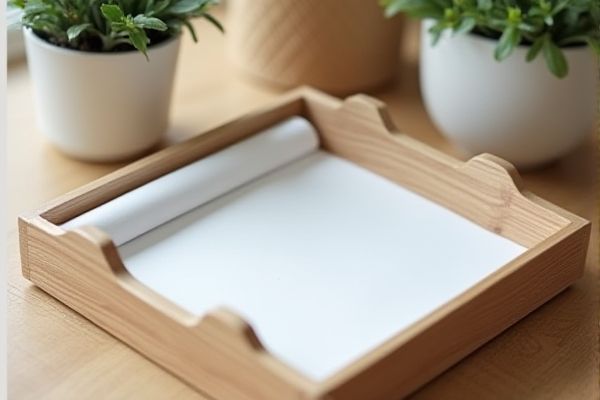
Paper trays are designed to hold blank sheets for printing or copying, ensuring smooth feeding and reducing jams, while letter trays organize and store sorted, incoming, or outgoing documents for easy access. Discover how choosing the right tray enhances your workspace efficiency by reading the rest of the article.
Table of Comparison
| Feature | Paper Tray | Letter Tray |
|---|---|---|
| Purpose | Holds blank paper sheets for printing | Organizes incoming/outgoing letters and documents |
| Typical Location | Printer or copier device | Desk or office workspace |
| Material | Plastic or metal, built into device | Plastic, metal, wood or wire-frame standalone organizer |
| Capacity | Usually 100-500 sheets of paper | Varies; typically holds 50-200 letters/documents |
| Function | Feeds paper into printers for printing tasks | Keeps letters and documents sorted and accessible |
| Usage Context | Printing and copying processes | Daily office correspondence and filing |
Introduction to Paper Trays and Letter Trays
Paper trays and letter trays both organize documents efficiently but serve distinct purposes based on size and function. Paper trays typically hold various paper sizes, making them versatile for printing or stacking multiple types of documents. Letter trays are specifically designed to hold standard letter-sized sheets, keeping Your workspace orderly and easily accessible.
Key Differences Between Paper Trays and Letter Trays
Paper trays are designed to hold and feed various sizes and types of paper into printers, adapting to different printing needs. Letter trays primarily serve as organizational tools for sorting and storing documents, emphasizing accessibility over media handling. Understanding the distinction between paper trays and letter trays helps optimize Your office workflow and equipment maintenance.
Material and Build Quality Comparison
Paper trays are typically made from sturdy plastic or metal to ensure durability and support heavy paper loads, while letter trays often feature lighter materials like plastic, wood, or metal with an emphasis on ease of access and aesthetic appeal. High-quality paper trays incorporate reinforced edges and anti-slip bases to maintain stability during frequent use, contrasting with letter trays that prioritize a sleek build for organizing documents visibly on desks. Your choice depends on whether you need robust material for bulk paper handling or a stylish, practical solution for sorting letters and smaller documents.
Size and Capacity: What Fits Best?
Paper trays typically accommodate larger paper sizes like letter (8.5" x 11") and legal (8.5" x 14"), offering higher capacity for standard printer sheets, whereas letter trays are designed specifically to hold only letter-sized documents, maximizing organization for that size. The size of paper trays is often adjustable to fit multiple paper dimensions, making them versatile for various printing needs, while letter trays maintain fixed dimensions that streamline sorting and storage of letter-size documents. Choosing between the two depends on whether you prioritize flexibility in paper handling or dedicated, space-efficient storage for letter-sized sheets.
Organizational Benefits of Paper Trays
Paper trays enhance office organization by categorizing documents, reducing clutter, and improving workflow efficiency. Unlike letter trays, which typically hold incoming and outgoing mail, paper trays can sort various types of paperwork such as invoices, reports, and memos, helping you quickly locate important documents. This systematic approach saves time and supports a more productive work environment.
Advantages of Letter Trays in the Workplace
Letter trays enhance workplace organization by providing a clear system for sorting and prioritizing documents, which increases efficiency and reduces clutter on your desk. They also save space by stacking vertically, allowing multiple categories of papers to be managed without occupying extensive surface area. This accessibility and neat arrangement help improve workflow and minimize the time spent searching for important correspondence or files.
Aesthetic and Design Considerations
Paper trays often feature a utilitarian design with stackable compartments, prioritizing function over form, making them suitable for offices requiring high-volume document sorting. Letter trays typically have a sleek, minimalistic appearance with open slots or tiers, enhancing desktop aesthetics by offering organized yet visually appealing storage for letters and small papers. Choosing between paper and letter trays depends on balancing the need for practical document management against the desire for a refined and professional workspace design.
Cost Analysis: Paper Tray vs Letter Tray
A paper tray typically costs more upfront than a letter tray due to its larger size and sturdier construction. Letter trays are generally cheaper and ideal for organizing standard letter-sized documents, making them cost-effective for simple office needs. When evaluating long-term value, paper trays offer greater versatility and durability, potentially reducing replacement costs over time.
User Scenarios: Which Tray Suits Your Needs?
Paper trays are ideal for storing blank sheets and organizing different paper types, making them perfect for users who frequently print or write on various paper sizes. Letter trays excel at sorting incoming and outgoing documents, helping you manage correspondence and paperwork efficiently in office environments. Choosing the right tray depends on whether your primary need is handling raw paper stock or organizing completed documents for easy access.
Conclusion: Choosing the Right Tray for Office Efficiency
Selecting the right tray between a paper tray and a letter tray significantly impacts office efficiency by optimizing document organization and workflow. Paper trays are ideal for sorting various paper sizes and high-volume prints, enhancing accessibility and reducing clutter. Letter trays excel in managing smaller correspondence and mail, streamlining task prioritization and improving overall desk management.
 homyna.com
homyna.com